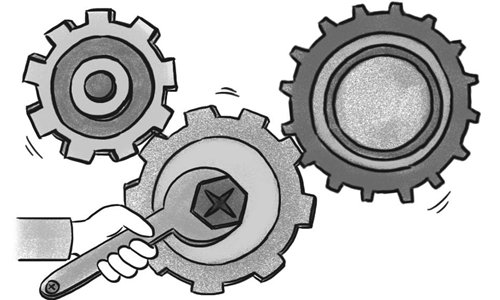HOME >> BUSINESS
Four crucial stages for China’s manufacturing success
Source:Global Times Published: 2019/9/22 19:03:39

Illustration: Xia Qing/GT
The development of strategic emerging industries is an important impetus for promoting the high-quality growth of the Chinese economy. According to the Classification of Strategic Emerging Industries (2018) issued by the National Bureau of Statistics, China's strategic emerging industries cover nine areas: next-generation information technology, high-end equipment manufacturing, new materials, biotechnology, new-energy vehicles, new energy, energy efficient and environmental technologies, digital innovation, and related services.From 2008 to 2017, China's strategic emerging industries drove GDP growth by more than 1 percentage point on average each year, contributing nearly 20 percent to the entire economic growth.
At present, with the world entering the fifth round of industrial transfer and production factor restructuring, the strive to develop strategic emerging industries will boost China's industrial structure toward medium to high-end and accelerate the construction of a modern industrial system.
Meanwhile, strategic emerging industries are in line with the latest scientific and technological innovation, which can attract large amounts of innovative inputs, gather a large number of innovative talents, and produce a great deal of innovative results.
The key to push forward with the development of China's strategic emerging industries is to focus on four stages of technological innovation and industrial cultivation.
First, we need to pay more attention to basic research input so as to improve the original supplies for innovation.
Statistics showed that in 2018, China's research and development (R&D) expenditures reached 1.97 trillion yuan ($277.8 billion), accounting for 2.19 percent of its GDP, a minor rise of 0.04 percentage points compared with the previous year.
However, although the Chinese government has achieved substantial results after years of heavy R&D investment, the proportion of R&D expenditure for core, high-end and basic technologies is not high. In 2018, basic research expenditure only totaled 109.04 billion yuan, accounting for 5.5 percent of the total R&D expenditure. By comparison, the US R&D expenditure is equivalent to about 4 percent of its GDP, with 17 percent of the total spent on core, high-end and basic technologies.
Therefore, it is necessary to make adjustments to China's R&D expenditure distribution system.
Second, we need to attach more importance to the transformation of scientific and technological results so as to smooth the application channel for innovative products.
The world average ratio of patents transforming into productivity is 40 percent, but in China, the figure is only 10 percent, with the remaining 90 percent shelved with little use.
The so-called Bayh-Dole Act in the US stipulates that investors have one-third of patent ownership, inventors also own one-third, and the remaining one-third ownership goes to those medium and small companies that are good at turning patents into productivity.
We don't have such a mechanism in China, so we have to address this problem in order to make the transformation of our intellectual property rights really work.
Third, emphasis should also be given to the cultivation of innovative enterprises so as to accelerate the innovative industrialization at the large-scale investment stage.
After transforming patents into productivity, enterprises need to increase investment, requiring the input of Series A, B and C funding rounds of investment.
In this sense, we need to establish a good STAR market - China's new NASDAQ-style board - and also need to build a very effective operating system for private equity funds and venture capital funds.
Fourth, we also need to pay more attention to the development of industrial clusters to achieve a chain reaction during an increasingly integrated industrial age.
Industries must find ways to turn unicorns and large-scale industries into a cluster.
There are three kinds of such clusters. One is the cluster in the upstream, middle and downstream of industries. For instance, Huawei has more than 7,000 component suppliers for its server production, and more than 1,000 component suppliers for its mobile phone manufacturing, which is a cluster of an industrial chain. Then, on the basis of an industrial chain, there will be a cluster of industries serving the chain, including logistics, settlement, finance, and financing. Finally, with the above two clusters, similar clusters will also gather around. Therefore, if the city, or the country, becomes the place gathering industrial chain clusters, service industry clusters and value chain clusters for major products in the world, its industry can really be developed.
The article was compiled based on a speech made by Huang Qifan, vice chairman of the China Center for International Economic Exchanges, at the International Forum on Innovation and Emerging Industries Development on September 18. bizopinion@globaltimes.com.cn
Posted in: INSIDER'S EYE